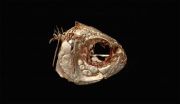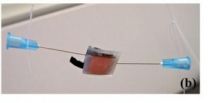(Press-News.org) Researchers have identified a genetic association with facial asymmetry in an ancient cavefish, a natural trait that may solve mysteries surrounding facial asymmetries in humans – conditions such as cleft palate or hemifacial microsomia. This exciting discovery by Joshua Gross, a University of Cincinnati assistant professor for the Department of Biological Sciences; and doctoral students Amanda Krutzler and Brian Carlson, is published in the research journal, Genetics.
The researchers are studying the craniofacial features of the eyeless, cave-dwelling fish, Astyanax mexicanus, which has lived in the pitch-black caves of the Sierra de El Abra region of Mexico for millions of years. They're comparing those features with closely related sighted surface-dwelling fish that are found in Mexico, Texas and New Mexico.
These cavefish have no eyes, although they are acutely sensitive to sound and vibration. Despite being eyeless, they have several similar bony features in their eye regions compared to their sighted, surface- dwelling counterparts. These similarities allowed the researchers to directly compare traits in the surface-dwelling fish with the cavefish. The cavefish, however, appear drastically different since they are albino and nearly translucent, compared with the darker pigmented surface-dwelling fish.
The researchers are screening the genomes of every individual fish from a hybrid pedigree housed in their lab – looking for genes that may lead to variations in eye size or pigmentation. In the cavefish, they discovered genetic markers on two separate chromosomes that are associated with extensive bone fragmentation on the right side of the skull. Although bone fragmentation also occurs on the left side of the skull, no genetic associations were detected when scoring on the left side of the cranium. The sighted surface-dwelling fish never demonstrated any of these craniofacial abnormalities.
"By understanding how genes are behaving differently on the right versus the left sides, we hope to discover why many craniofacial alterations are more severe or present on only one side of the face in humans," says Gross.
Researchers are now narrowing in on the precise genes associated with these cranial abnormalities, with indications that two genes previously shown to be associated with cleft palate in humans, bone morphogenetic protein number four (BMP4) and transforming growth factor beta family member 3 (TGFB3), may similarly be involved in natural forms of bone asymmetry.
Previous research discovered that the gene that causes red hair and pale skin in humans was the same gene that caused the albino-like cavefish to have less pigmentation than the surface-dwelling species.
Funding for the research was supported by a federal grant from the National Institute of Dental and Craniofacial Research, National Institutes of Health.
Building a Family Pedigree
The researchers bred the cave fish with the surface-dwelling fish, and then intercrossed the hybrid offspring. Some members of this family pedigree resembled the albino qualities of the cave-dwelling fish but had a perfectly well-developed eye. Others demonstrated the dark pigmentation qualities of the surface-dwelling parent, but had a very small eye.
"We can make progress towards understanding the genetic origin of several analogous human disorders by expanding the repertoire of model systems represented by lab mice, zebrafish and so forth," explains Gross. "Many techniques and technologies have been developed in these powerful model systems, however they're extremely inbred. As a result, an inbred model system is not going to enable us to understand how and why craniofacial abnormalities evolve in nature. We can use the blind Pachón cave-dwelling fish to inform unresolved questions, such as how and why asymmetric craniofacial malformations occur in humans."
"Additional research, utilizing an increasing number of emerging cave-dwelling models, offers the exciting prospect of clarifying longstanding problems in contemporary evolutionary and vertebrate biology," says Gross.
High-Tech Imagery Used to Support Research
The UC researchers are using cutting-edge technology as they build a high-resolution, three-dimensional reconstructions of hybrids of the surface-dwelling and cave-dwelling fish, Astyanax mexicanus. The researchers turned to the Imaging Resource Center at Cincinnati Children's Hospital Medical Center to perform an imaging technique called micro-computed tomography, or micro-CT, on more than 200 related fish. The technology allowed the researchers to capture more than 1,000 X-ray images for each fish, which they combined and rendered into a high-resolution, 3-D skull, using the Amira software program.
Doctoral student and researcher Amanda Krutzler says the interactive program allows the researchers to rotate the fish skull in 3-D and take precise measurements for any traits of interest. In addition, micro-CT allows the researchers to visualize soft tissues, such as the brain or cardiovascular systems. "These scans will generate a massive amount of data for our lab, which will provide projects for undergraduate students and graduate students like me," says Krutzler. The National Institute of Dental and Craniofacial Research grant provided the funding for the software.
In addition, doctoral student Brian Carlson used Circos software to visualize the connections between the cavefish genome and the zebrafish genome. "The more markers shared between a given cavefish linkage group and zebrafish chromosome, the thicker the ribbon that connects them. These representations are helpful in highlighting similarities between the cavefish and zebrafish genomes and may ultimately aid in identifying the genetic loci underlying the traits we examine by indicating which portions of the zebrafish genome may harbor genes that affect these traits," says Carlson.
INFORMATION:
About the Journal, Genetics
Founded in 1916, the journal Genetics is the first American journal in its field and is published by the Genetics Society of America. The journal publishes novel findings on a range of topics involving inheritance, including population and evolutionary genetics, complex traits, developmental and behavioral genetics and more.
The Department of Biological Sciences at UC
UC's biological sciences department, housed in the McMicken College of Arts and Sciences (A&S), is dedicated to excellence in research, graduate training, undergraduate education and community engagement. The department's research is supported by a broad range of grants from federal and private research foundations.
Examination of a cave-dwelling fish finds a possible genetic link to human disorders
2014-04-03
ELSE PRESS RELEASES FROM THIS DATE:
Synergy of high protein intake and exercise in youth enhances bone structure and strength
2014-04-03
A study presented during the World Congress on Osteoporosis, Osteoarthritis and Musculoskeletal Diseases in Seville shows that high levels of protein intake (HProt) enhance the positive impact of high physical activity (HPA) on bone structure and strength in healthy pre-pubertal boys.
Researchers from the University of Geneva in Switzerland and Eindhoven University in the Netherlands tracked 176 healthy pre-pubertal boys (average age 7.4 years) to mid-adolescence (average age 15.2 years). Compared to moderate protein intake, HProt in combination with HPA was associated ...
Adults' tonsillectomy complications are higher than previously thought
2014-04-03
Twenty percent of adults who have tonsillectomies will have a complication, which is significantly higher than previously shown, according to a team of researchers. The team also found that these complications substantially increase health care expenditures.
"Since 1973, John Wenneberg and his colleagues at Dartmouth have been examining variation in the rates of tonsillectomy performed across regions, trying to explain why such wide variation is observed," said Dennis Scanlon, professor of health policy and administration, Penn State. "In other words, why are some patients ...
Report documents cardiopulmonary arrest in premature infant after cyclomydril eyedrops
2014-04-03
San Francisco, CA, April 2, 2014 – Eyedrops administered to infants as part of routine outpatient retinopathy of prematurity (ROP) screening can have life-threatening consequences. A case report published in the current issue of the Journal of the American Association for Pediatric Ophthalmology and Strabismus (AAPOS) describes cardiopulmonary arrest in a 27-week-old infant following administration of three sets of cyclopentolate 0.2%/phenylephrine 1% (Cyclomydril) eyedrops.
"Cardiopulmonary arrest can occur from just instillation of eyedrops in a premature infant seen ...
Drawing conclusions
2014-04-03
Is a picture worth only a thousand words? According to Dr. Carmit Katz of Tel Aviv University's Bob Shapell School of Social Work, illustrations by children can be a critical tool in forensic investigations of child abuse.
Dr. Katz's study, published in Child Abuse and Neglect, compared the results when child abuse victims were offered the opportunity to draw during questioning with victims not offered this opportunity. Her findings saw a significant difference, suggesting a therapeutic value and indicating that children empowered to draw pictures about their abuse provided ...
Radium-223 dichloride in prostate cancer: Major added benefit for certain patients
2014-04-03
Radium-223 dichloride (radium-223 for short, trade name: Xofigo) has been approved since November 2013 for men with advanced prostate cancer, in whom hormone blockade is no longer effective, and symptomatic bone metastases, but without visceral metastases. In an early benefit assessment pursuant to the Act on the Reform of the Market for Medicinal Products (AMNOG), the German Institute for Quality and Efficiency in Health Care (IQWiG) examined whether this new drug offers an added benefit over the appropriate comparator therapy specified by the Federal Joint Committee (G-BA).
No ...
Nanoparticles cause cancer cells to self-destruct
2014-04-03
Using magnetically controlled nanoparticles to force tumour cells to 'self-destruct' sounds like science fiction, but could be a future part of cancer treatment, according to research from Lund University in Sweden.
Watch video:https://www.youtube.com/watch?v=vos0QW2Yclk&feature=youtu.be
"The clever thing about the technique is that we can target selected cells without harming surrounding tissue. There are many ways to kill cells, but this method is contained and remote-controlled", said Professor Erik Renström.
The point of the new technique is that it is much more ...
Tiny power generator runs on spit
2014-04-03
Saliva-powered micro-sized microbial fuel cells can produce minute amounts of energy sufficient to run on-chip applications, according to an international team of engineers.
Bruce E. Logan, Evan Pugh Professor and Kappe Professor of Environmental Engineering, Penn State, credited the idea to fellow researcher Justine E. Mink. "The idea was Justine's because she was thinking about sensors for such things as glucose monitoring for diabetics and she wondered if a mini microbial fuel cell could be used," Logan said. "There is a lot of organic stuff in saliva."
Microbial ...
Attracting wild bees to farms is a good insurance policy
2014-04-03
EAST LANSING, Mich. -- Investing in habitat that attracts and supports wild bees in farms is not only an effective approach to helping enhance crop pollination, but it can also pay for itself in four years or less, according to Michigan State University research.
The paper, published in the current issue of the Journal of Applied Ecology, gives farmers of pollination-dependent crops tangible results to convert marginal acreage to fields of wildflowers, said Rufus Isaacs, MSU entomologist and co-author of the paper.
"Other studies have demonstrated that creating flowering ...
Pulmonary hypertension deaths have increased over past decade according to CDC report in CHEST
2014-04-03
Deaths from pulmonary hypertension have increased over the past decade, according to a study from the Centers for Disease Control and Prevention (CDC).
In the study, published online in CHEST, researchers analyzed death rates from the National Vital Statistics System and data from the National Hospital Discharge Survey between 2001 and 2010 to analyze trends in hospitalizations and death rates related to pulmonary hypertension.
Pulmonary hypertension is characterized by increased blood pressure in the pulmonary arteries, causing the right side of the heart to work ...
Tiny biomolecular tweezers studying force effect of cells
2014-04-03
A new type of biomolecular tweezers could help researchers study how mechanical forces affect the biochemical activity of cells and proteins. The devices — too small to see without a microscope — use opposing magnetic and electrophoretic forces to precisely stretch the cells and molecules, holding them in position so that the activity of receptors and other biochemical activity can be studied. Arrays of the tweezers could be combined to study multiple molecules and cells simultaneously, providing a high throughput capability for assessing the effects of mechanical forces ...



